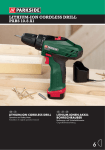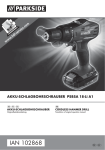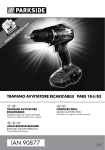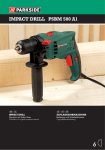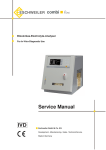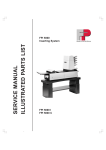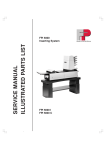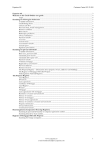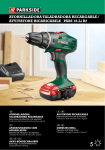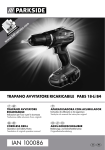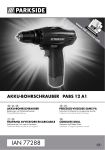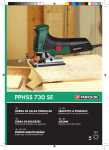Download 38174_LITHIUM-ION CORDLESS
Transcript
PABS10.8-LI APARAFUSADORA COM BATERIA DE IÕES DE LÍTIO Instruções de utilização e de segurança Tradução do manual de instruções original LITHIUM-IONEN-AKKUBOHRSCHRAUBER Bedienungs- und Sicherheitshinweise Originalbetriebsanleitung LITHIUM-ION CORDLESS DRILL Operation and Safety Notes Translation of original operation manual Antes de começar a ler abra na página com as imagens e, de seguida, familiarize-se com todas as funções do aparelho. Before reading, unfold the page containing the illustrations and familiarise yourself with all functions of the device. Klappen Sie vor dem Lesen die Seite mit den Abbildungen aus und machen Sie sich anschließend mit allen Funktionen des Gerätes vertraut. PT GB DE / AT / CH Instruções de utilização e de segurança Operation and Safety Notes Bedienungs- und Sicherheitshinweise Página 5 Page 15 Seite 25 1 2 4 3 12 11 10 5 6 7 8 9 A B C D 13 14 15 1 4 16 2 Índice Introdução Utilização correcta........................................................................................................Página Equipamento .................................................................................................................Página Volume de fornecimento ...............................................................................................Página Dados técnicos ..............................................................................................................Página 6 6 6 6 Indicações de segurança gerais para ferramentas eléctricas 1. Segurança no local de trabalho ..............................................................................Página 7 2. Segurança eléctrica ..................................................................................................Página 8 3. Segurança pessoal ...................................................................................................Página 8 4. Manuseamento e utilização cuidada de ferramentas eléctricas...........................Página 9 5. Utilização e tratamento da ferramenta a bateria ..................................................Página 9 Atenção cabos! .............................................................................................................Página 10 Aparelhos adicionais e acessórios de origem ............................................................Página 10 Indicações de segurança para aparafusadora sem fio .............................................Página 10 Antes da utilização Retirar / carregar / colocar o conjunto de bateria ......................................................Página Verificar o estado da bateria .......................................................................................Página Substituir ferramenta .....................................................................................................Página Engrenagem de 2 velocidades ....................................................................................Página Pré-selecção de níveis de binário / nível de perfuração .............................................Página 10 10 11 11 11 Colocação em funcionamento Alterar o sentido de rotação / desbloquear o aparelho ............................................Página Ligar / desligar...............................................................................................................Página Activar o bloqueio.........................................................................................................Página Sugestões ......................................................................................................................Página 11 11 12 12 Manutenção e limpeza ..................................................................................Página 12 Assistência ................................................................................................................Página 13 Garantia.....................................................................................................................Página 13 Eliminação ................................................................................................................Página 13 Declaração de conformidade / Fabricante....................................Página 14 PT 5 Introdução Neste manual de instruções são utilizados os seguintes símbolos / gráficos: Ler o manual de instruções! Manter a ferramenta eléctrica fora do alcance das crianças! Considerar as indicações de aviso e de segurança! Apenas para utilização em espaços interiores! Perigo de choque eléctrico! Perigo de morte! Ter atenção ao estado do aparelho, cabo de rede e ficha de rede! Perigo de explosão! Aparafusadora sem fio PABS 10.8-LI Introdução Antes da primeira colocação em funcionamento familiarize-se com as funções do aparelho e informe-se acerca do mnuseio correcto com as ferramentas eléctricas. Leia o seguinte manual de instruções e as indicações de segurança. Conserve este manual. Se entregar este aparelho a terceiros, forneça toda a documentação. Utilização correcta Este aparelho é concebido para furar e aparafusar em madeira, material sintético e metal. Utilize o aparelho apenas como descrito e nas áreas de aplicação indicadas. Qualquer outra utilização ou alteração do aparelho é tida como incorrecta e acarreta perigo de acidentes graves. O fabricante não se responsabiliza por quaisquer danos causados por uma utilização incorrecta. Não é destinado para a utilização comercial. 12 13 14 15 16 Suporte de bit Inversor do sentido de rotação / bloqueio Interruptor LIGAR / DESLIGAR Pega macia Conjunto de bateria Tecla de desbloqueio da bateria Luz Pré-selecção de níveis de binário / nível de perfuração Mandril de brocas de aperto rápido Fonte de alimentação LED vermelho de controlo Indicação do estado de carga verde Ponta do carregador Volume de fornecimento 4 5 6 7 8 9 10 11 1 Aparafusadora sem fio PABS 10.8-LI 1 Conjunto de bateria PABS 10.8-LI-1 1 Fonte de alimentação PABS 10.8-LI-2 com ponta de carregador 2 Bits no suporte de bits (CR-VPH1, CR-VPH2) 1 Mala de transporte 1 Manual de instruções 1 Selector de velocidades 2 Botão LED de bateria 3 LED de bateria (Indicação do estado da bateria) 6 Dados técnicos Equipamento PT Aparafusadora sem fio PABS 10.8-LI: Tensão nominal: 10.8 V Rotação em ralenti: 1.ª velocidadade: 400 rpm 2.ª velocidade: 1300 rpm Introdução / Indicações de segurança gerais para ferramentas eléctricas Capacidade de fixação do mandril de brocas: máx. 10 mm Diâmetro máximo de perfuração: Aço: 8 mm Madeira: 20 mm Conjunto de bateria PABS 10.8-LI-1: Tipo: IÕES DE LÍTIO Tensão nominal: 10,8 V Capacidade: 1300 mAh Fonte de alimentação PABS 10.8-LI-2: ENTRADA / Input: Tensão nominal: 230 V ~ / 50 Hz SAÍDA / Output: Tensão nominal: Corrente nominal: Duração da carga: 12 V 0,6 A aprox. 3 horas Informação sonora/vibratória Valor de medição para o ruído determinado em conformidade com EN 60745. O nível de ruído da ferramenta eléctrica avaliado com A importa tipicamente em: Nível de pressão sonora: 70 dB(A) Nível da potência acústica: 80 dB(A) Tolerância K: 3 dB Utilizar protecção de ouvidos! Valores de vibração total (soma de vectores de três direcções) determinados segundo EN 60745: Perfurar metal: Aparafusar: Valor de emissão de vibração ah, D= 1,944 m / s2, tolerância K= 1,5 m / s2, Valor de emissão de vibração ah= 2,101 m / s2, tolerância K= 1,5 m / s2. AVISO! O nível de ruído indicado nas instruções foi medido através de um processo de medição segundo a norma EN 60745 e pode ser utilizado para fins comparativos de aparelhos. O nível de ruído altera de acordo com a aplicação da ferramenta eléctrica, excedendo, em alguns casos, o valor indicado. O grau de vibração pode ser subestimado quando a ferramenta é utilizada frequentemente desta forma. Nota: Para uma avaliação exacta do grau de vibração durante um determinado período de trabalho, deve-se também ter em conta os períodos de tempo em que o aparelho está desligado ou está ligado, mas não está a ser utilizado. Isto pode reduzir significativamente o grau de vibração durante o período total de trabalho. Indicações de segurança gerais para ferramentas eléctricas AVISO! Leia todas as indicações de segurança e instruções! A inobservância das indicações de segurança e instruções pode conduzir a choques eléctricos, incêndios e / ou ferimentos graves. GUARDE TODAS AS INDICAÇÕES DE SEGURANÇA E INSTRUÇÕES PARA CONSULTA FUTURA! O CONCEITO “FERRAMENTA ELÉCTRICA”, UTILIZADO NAS INDICAÇÕES DE SEGURANÇA, REFERE-SE A FERRAMENTAS ELÉCTRICAS ALIMENTADAS A ELECTRICIDADE (COM CABO DE REDE) E A FERRAMENTAS ELÉCTRICAS ALIMENTADAS POR BATERIA (SEM CABO DE REDE). 1. Segurança no local de trabalho a) Mantenha o seu local de trabalho limpo e bem iluminado. A desordem e a má iluminação da área de trabalho podem provocar acidentes. b) Não utilize o aparelho em áreas potencialmente explosivas, nas quais se encontrem líquidos, gases ou poeiras inflamáveis. As ferramentas eléctricas produzem faíscas que podem inflamar as poeiras ou os vapores. PT 7 Indicações de segurança gerais para ferramentas eléctricas c) Não deixe que crianças ou quaisquer outras pessoas se aproximem quando utilizar a ferramenta eléctrica. Se se distrair pode perder o controlo do aparelho. 2. Segurança eléctrica Evite o perigo de vida por choque eléctrico: a) A ficha de ligação do aparelho tem de estar em conformidade com a tomada. A ficha não deve ser alterada, de forma alguma. Não utilize fichas adaptadoras com aparelhos protegidos por ligação à terra. As fichas não sujeitas a modificações e as respectivas tomadas reduzem o risco de choque eléctrico. b) Evite o contacto físico com superfícies ligadas à terra tais como tubos, aquecedores, fogões e frigoríficos. Se o seu corpo estiver ligado à terra, existe um risco elevado de choque eléctrico. c) Mantenha o aparelho afastado de chuva ou humidade. A penetração da água no aparelho eléctrico aumenta o risco de choque eléctrico. d) Não use o cabo para fins inadequados, como para transportar o aparelho, para o pendurar ou para puxar a ficha da tomada. Mantenha o cabo afastado do calor, óleos, arestas afiadas ou peças móveis do aparelho. Um cabo danificado ou mal enrolado aumenta o risco de um choque eléctrico. e) Quando trabalhar com um aparelho eléctrico ao ar livre, utilize apenas extensões que sejam adequadas para áreas exteriores. A utilização de uma extensão destinada a áreas exteriores diminui o risco de choque eléctrico. f) Se não for possível evitar a utilização da ferramenta eléctrica num ambiente húmido, utilize um disjuntor de corrente 8 PT de avaria. A utilização de um disjuntor de corrente de avaria reduz o risco de choque eléctrico. 3. Segurança pessoal a) Seja prudente, preste sempre atenção àquilo que está a fazer e utilize a ferramenta eléctrica de forma sensata. Não utilize o aparelho quando estiver cansado ou sob a influência de drogas, álcool ou medicamentos. Mesmo um pequeno descuido, durante a utilização do aparelho, pode causar ferimentos graves. b) Utilize equipamento de protecção individual e nunca se esqueça dos óculos de protecção. A utilização de equipamento de protecção individual como máscara anti-poeiras, calçado de protecção anti-derrapante, capacete ou protecção auditiva, conforme o tipo e a aplicação da ferramenta eléctrica, diminui o risco de ferimentos. c) Evite uma colocação em funcionamento acidental. Certifique-se de que a ferramenta eléctrica está desligada, antes de a ligar à fonte de alimentação, levantar ou transportar. Se, durante o transporte do aparelho, tiver colocado o dedo no interruptor LIGAR / DESLIGAR ou se o aparelho estiver ligado, este pode causar acidentes. d) Afaste a ferramenta de ajuste ou a chave de porcas, antes de ligar o aparelho. Uma ferramenta ou chave que esteja colocada numa peça rotativa do aparelho pode causar ferimentos. e) Evite uma postura anormal do corpo. Certifique-se de que se encontra numa posição estável e mantenha sempre o equilíbrio. Desta forma, pode controlar melhor o aparelho, particularmente em imprevistos. f) Use vestuário adequado. Não utilize roupas largas ou bijutaria. Mantenha o cabelo, a roupa e as luvas afastados de peças móveis. O vestuário largo, a bijutaria ou os cabelos compridos podem ficar presos nas peças móveis. Indicações de segurança gerais para ferramentas eléctricas g) Quando montar dispositivos de aspiração ou recolha de poeiras, certifique-se de que estes estão bem ligados e são utilizados correctamente. A utilização destes dispositivos diminui a existência de perigos potenciados por poeiras. 4. Manuseamento e utilização cuidada de ferramentas eléctricas a) Não sobrecarregue o aparelho. Utilize a ferramenta eléctrica mais adequada para o seu trabalho. Trabalhará melhor e de forma mais segura se utilizar a ferramenta eléctrica adequada à respectiva área de trabalho. b) Não utilize ferramentas eléctricas, cujo interruptor esteja avariado. Uma ferramenta eléctrica que não possa mais ser ligada ou desligada constitui perigo e tem de ser reparada. c) Retire a ficha da tomada antes de efectuar ajustes no aparelho, trocar acessórios ou quando deixar de utilizar o aparelho. Esta medida de segurança impede o arranque involuntário do aparelho. d) Mantenha as ferramentas eléctricas que não estejam a ser utilizadas fora do alcance das crianças. Não deixe que pessoas que não estejam familiarizadas com o aparelho, ou que não tenham lido estas instruções, o utilizem. As ferramentas eléctricas são perigosas, quando manuseadas por pessoas inexperientes. e) Trate do aparelho com cuidado. Verifique se as peças móveis do aparelho funcionam correctamente, se não ficam encravadas e se estão partidas ou danificadas a ponto de prejudicar o bom funcionamento do aparelho. Repare as peças danificadas antes da utilização do aparelho. Muitos acidentes ocorrem devido à má manutenção das ferramentas eléctricas. f) Mantenha a ferramenta de corte afiada e limpa. Ferramentas de corte bem tratadas com gume afiado ficam encravadas com menor regularidade e podem ser utilizadas mais facilmente. g) Utilize a ferramenta eléctrica, acessórios, ferramentas de aplicação, etc. de acordo com estas instruções e tal como é indicado para este tipo específico de aparelho. Tenha em atenção as condições de trabalho e a actividade que vai desempenhar. A utilização de ferramentas eléctricas para outras aplicações que não as previstas, pode originar situações de perigo. 5. Utilização e tratamento da ferramenta a bateria a) Carregue as baterias apenas nos carregadores recomendados pelo fabricante. Num carregador apropriado para um tipo específico de bateria, existe o risco de incêndio, se este for utilizado com outras baterias. b) Utilize apenas nos aparelhos eléctricos as baterias previstas para o efeito. O uso de outras baterias pode representar perigo de ferimentos e de incêndio. c) Mantenha a bateria não utilizada afastada de clips, moedas, chaves, pregos, parafusos ou outros objectos metálicos pequenos, pois estes podem originar uma ligação em ponte dos contactos. Um curto-circuito entre contactos de bateria pode causar queimaduras ou incêndio. d) AVISO! Se a bateria estiver a ser incorrectamente utilizada, esta poderá verter. Nesse caso, evite o contacto. Em caso de contacto acidental, lavar bem com água. Se este líquido entrar em contacto com os olhos, dirijase imediatamente a um médico. O líquido vertido da bateria pode provocar irritações na pele ou queimaduras. PT 9 Indicações de segurança gerais para ferramentas eléctricas / Antes da utilização Atenção cabos! AVISO! Certifique-se de que não entra em contacto com cabos de electricidade, gás ou de tubos de água quando estiver a trabalhar com uma ferramenta eléctrica. Se necessário, verifique com um localizador de cabos antes de perfurar ou abrir uma parede. Aparelhos adicionais e acessórios de origem Utilize apenas acessórios e aparelho adicionais que estão mencionados no manual de instruções. A utilização de outras ferramentas eléctricas ou acessórios do que os recomendados no manual de instruções pode significar perigo de ferimentos para si. Indicações de segurança para aparafusadora sem fio Fixe a peça de trabalho. Uma peça de 10 trabalho fixa mediante dispositivos de fixação ou um torno de bancada estará mais segura do que se for fixa com a sua mão. AVISO! POEIRAS TÓXICAS! As poeiras nocivas / tóxicas resultantes do trabalho colocam em perigo a saúde do operante ou das pessoas que se encontrarem nas proximidades. Use óculos de protecção e máscara anti-pó! Não trabalhe material que contenha amianto. O amianto é cancerígeno. Fixe a ferramenta eléctrica. Ao apertar e soltar os parafusos podem ocorrer brevemente elevados binários de reacção. Desligue imediatamente a ferramenta eléctrica quando a ferramenta de aplicação bloquear. Esteja atento aos elevados binários de reacção que originam um rebate. A ferramenta de aplicação bloqueia quando a ferramenta eléctrica está sobrecarregada ou quando engata na peça a trabalhar. PT AVISO! Segure a ferramenta eléctrica apenas nas superfícies isoladas do punho, enquanto realiza trabalhos nos quais a ferramenta de aplicação pode atingir cabos eléctricos torcidos. O contacto com um cabo condutor de tensão coloca também as peças metálicas da ferramenta eléctrica sob tensão e pode conduzir a um choque eléctrico. Durante os trabalhos no aparelho, bem como aquando do transporte e armazenamento, coloque o inversor do sentido de rotação na posição intermédia (bloqueio). Desta forma, evita um arranque acidental da ferramenta eléctrica. Antes da utilização Retirar / carregar / colocar o conjunto de bateria Nota: A bateria é fornecida parcialmente carregada. Antes da primeira utilização, carregue a bateria durante, pelo menos, 3 horas no carregador. Desta forma, assegura a capacidade total da bateria. Pode carregar a bateria de iões de lítio em qualquer altura, sem encurtar a sua vida útil. Uma interrupção do processo de carregamento não danifica a bateria. 1. Para retirar o conjunto da bateria 8 prima a tecla de desbloqueio 9 e extraia o conjunto de bateria 8 do aparelho. 2. Coloque a ponta do carregador 16 no conjunto de bateria 8 . 3. Encaixe o carregador 13 na tomada. O LED de controlo 14 acende a vermelho. 4. O LED da indicação do estado de carga 15 indica-lhe que o processo de carga está concluído e que o conjunto de bateria 8 está operacional. 5. Encaixe o conjunto da bateria 8 no aparelho. Verificar o estado da bateria Para verificar o estado da bateria, prima a tecla LED da bateria 2 (ver também figura principal). Antes da utilização / Colocação em funcionamento O estado ou a potência residual é mostrado através do LED de bateria 3 como se segue: VERDE / VERMELHO / LARANJA = carga / potência máxima VERMELHO / LARANJA = carga / potência média VERMELHO = carga fraca - carregar a bateria Substituir ferramenta A sua aparafusadora sem fios possui uma retenção automática do fuso . No caso da paragem do motor a cablagem de accionamento é bloqueada, de forma a que possa abrir o mandril de broca rápido 12 rodando . Depois de ter aplicado a ferramenta desejada e apertando-a com o mandril de broca pode continuar a trabalhar. A retenção do fuso solta-se automaticamente com o arranque do motor (activação do interruptor LIGAR / DESLIGAR 6 ). Engrenagem de 2 velocidades Nota: Accione o selector de velocidades 1 apenas com o aparelho imobilizado. Na primeira velocidade (interruptor selectivo das velocidades 1 na posição: 1) atinge uma velocidade de rotação de aprox. 400 min-1 e um binário elevado. Esta regulação é indicada para vários trabalhos de aparafusamento. Na primeira velocidade (interruptor selectivo das velocidades 1 na posição: 2) alcança uma rotação de aprox. 1300 min-1 para efectuar trabalho de perfuração. Pré-selecção de níveis de binário / nível de perfuração Pode definir a intensidade da rotação mediante a pré-selecção de níveis de binário / nível de perfuração 11 . Se a força de tracção ajustada for alcançada, o engate separa o accionamento. Seleccione um nível mais baixo para parafusos pequenos, materiais macios. Seleccione um nível elevado para parafusos grandes, materiais duros ou ao desaparafusar os parafusos. Para trabalhos de perfuração, seleccione o nível de perfuração, ajustando a pré-selecção do binário na posição . Para trabalho de perfurações desloque o interruptor selectivo das velocidades 1 para a frente (posição: 2). Colocação em funcionamento Alterar o sentido de rotação / desbloquear o aparelho Desbloqueie o aparelho e altere o sentido de rotação deslocando o inversor do sentido de rotação 5 para a direita ou para a esquerda. Ligar / desligar Ligar: Para colocação em funcionamento do aparelho prima o interruptor LIGAR / DESLIGAR 6 e mantenha-o premido. A lâmpada 10 está ligada quando o interruptor LIGAR / DESLIGAR 6 estiver pressionado levemente ou completamente e possibilita a iluminação da área de trabalho em caso de más condições de luz. Desligar: Solte o interruptor LIGAR / DESLIGAR para desligar o aparelho 6 . Alterar a rotação: O interruptor de LIGAR / DESLIGAR 6 dispõe de uma regulação da velocidade variável. Uma pressão leve do interruptor LIGAR / DESLIGAR 6 provoca uma rotação baixa. Aumentando a pressão ,a rotação aumenta também. PT 11 Colocação em funcionamento / Manutenção e limpeza Marque o ponto onde pretende furar com um Activar o bloqueio Pressione o interruptor do sentido de rotação 5 na posição intermédia. O interruptor LIGAR / DESLIGAR 6 está bloqueado. Sugestões Ao aparafusar em madeira, metal e em outros materiais: Antes do funcionamento verifique se a broca ou o parafuso está correctamente colocado, isto quer dizer se está centrado no mandril de broca. Brocas de aparafusar estão identificadas com as suas medidas e a forma. Se não tiver a certeza experimente sempre primeiro se a broca assenta sem folga na cabeça do parafuso. Binário: Especialmente brocas e parafusos pequenos podem ficar danificados se tiverem um binário demasiado elevado ou / e ajustar uma rotação demasiadamente elevada na máquina. ponto de centragem ou um prego e seleccione para iniciar o furo numa rotação baixa. Puxe a broca rotativa várias vezes do buraco para remover aparas ou pó de perfuração e para ventilá-lo. Furar em metal: Utilize uma broca de metal (HSS). Para melhores resultados deverá arrefecer a broca com óleo. Também pode utilizar a broca de metal para perfurar material sintético. Furar em madeira: Utilize uma broca de madeira com ponto de centragem, para furos fundos utilize uma „Broca para madeira”, para diâmetros de furos grandes utilize uma broca com ponto de centragem. Pode aparafusar directamente os parafusos pequenos em madeira macia sem pré-perfuração. Manutenção e limpeza Caso duro de aparafusamento: Binários extremamente elevados originam-se, por exemplo, nas uniões metálicas roscadas utilizando aplicadores de chaves de caixa. Seleccione uma rotação mais baixa. CUIDADO! Antes de iniciar todos os trabalhos no aparelho, por ex. mudança de ferramenta ou manutenção, bem como aquando do transporte ou armazenamento, coloque o inversor do sentido de rotação 5 na posição intermédia. Se o interruptor LIGAR / DESLIGAR 6 for acidentalmente accionado, existe o perigo de ferimentos. Caso macio de aparafusamento: Aparafuse também aqui com uma rotação reduzida, para não danificar, por exemplo, a superfície de madeira no contacto com a cabeça do parafuso em metal. Utilize uma fresa. Antes de todos os trabalhos de limpeza e manutenção, retire a fonte de alimentação 13 da tomada e remova a bateria. Ao perfurar em madeira, metal e em outros materiais: Utilize no caso de um diâmetro de broca pequeno uma rotação elevada e no caso de um diâmetro de broca grande uma rotação baixa. Seleccione uma rotação baixa em matérias duros e uma rotação alta em materiais macios. Segure e fixe (se possível) a peça a ser trabalhada numa ferramenta de fixação. A aparafusadora a bateria está livre de manutenção. O aparelho deve estar sempre limpo, seco e sem óleo nem lubrificantes. Limpe o aparelho imediatamente após a conclusão do trabalho. Não devem entrar líquidos para o interior do aparelho. Utilize um pano para a limpeza da caixa. Nunca utilize gasolina, produtos de limpeza ou detergentes que sejam agressivos para o plástico. 12 PT Assistência / Garantia / Eliminação Assistência PT AVISO! Os seus aparelhos devem ser reparados apenas pelo serviço de assistência técnica ou por pessoal técnico qualificado, e apenas com peças de substituição originais. Deste modo, assegura a preservação da segurança do aparelho. AVISO! A substituição da ficha ou do cabo de alimentação deve ser efectuada pelo fabricante do aparelho ou pelo serviço de apoio ao cliente. Deste modo, assegura a preservação da segurança do aparelho. Kompernaß Service Portugal Tel.: 707 780 707 (0,12 € por minuto) e-mail: [email protected] Garantia Segundo a directiva europeia 2002 / 96 / EC relativa a aparelhos eléctricos e electrónicos usados e respectiva conversão no direito nacional, as ferramentas eléctricas usadas devem ser recolhidas separadamente e sujeitas a uma reciclagem ecológica. Este aparelho tem uma garantia de 3 anos a partir da data de compra. O aparelho foi cuidadosamente produzido e verificado antes de ser entregue. Guarde o talão de caixa como comprovativo da compra. Para questões relacionadas com a garantia contacte telefonicamente o seu posto de assistência. Apenas desta forma pode ser garantido um envio do seu produto sem quaisquer custos. Esta garantia é válida apenas para o primeiro comprador e não é transmissível a terceiros. A garantia aplica-se somente a erros de material e de fabrico, mas a para peças de desgaste ou a danos de peças frágeis como p.ex. interruptores ou pilhas. O produto destina-se somente ao uso privado e não ao uso industrial. Eliminação A embalagem consiste exclusivamente de materiais amigos do ambiente. Elimineos nos pontos de recolha de reciclagem local. Não deite as ferramentas eléctricas no lixo doméstico! Não coloque as baterias no lixo doméstico! As baterias avariadas ou usadas têm de ser recicladas em conformidade com a directiva 2006 / 66 / EC. Para tal, leia também as indicações de segurança especiais para o aparelho de carregamento e para o conjunto de baterias. Pode obter informações relativas à eliminação do aparelho já usado através dos responsáveis legais pela reciclagem no seu município. A garantia caduca no caso de uso incorrecto, uso de força maior e intervenções não executadas pela nossa delegação de assistência autorizada. Esta garantia não restringe os seus legítimos direitos. PT 13 Declaração de conformidade / Fabricante Declaração de conformidade / Fabricante Nós, a sociedade Kompernaß GmbH, responsável de documentos: senhor Dennis Dohm, Burgstr. 21, D-44867 Bochum, Alemanha, explicamos pela presente que este produto corresponde às seguintes normas, os documentos normativos e as directivas CE: Directivas da máquina (2006 / 42 / EC) Directiva de baixa tensão da UE (2006 / 95 / EC) Compatibilidade Electromagnética (2004 / 108 / EC) Tipo/Designação do aparelho: Aparafusadora sem fio PABS 10.8-LI Date of manufacture (DOM): 12 - 2009 Bochum, 31.12.2009 Hans Kompernaß - Gerente - São reservadas as alterações técnicas no âmbito do desenvolvimento. 14 PT Table of contents Introduction Intended purpose ..........................................................................................................Page Equipment Components ...............................................................................................Page Items supplied................................................................................................................Page Technical Data...............................................................................................................Page 16 16 16 16 General safety advice for electrical power tools 1. Workplace safety .....................................................................................................Page 2. Electrical safety .........................................................................................................Page 3. Personal safety ..........................................................................................................Page 4. Careful handling and use of electrical power tools................................................Page 5. Use and handling of the cordless electrical power tool.........................................Page Attention - Service lines!................................................................................................Page Original ancillaries / accessories .................................................................................Page Safety advice relating to cordless drill drivers.............................................................Page 17 18 18 18 19 19 19 20 Before first use Removing / charging / inserting rechargeable battery pack ......................................Page Checking the battery status ..........................................................................................Page Changing tools ..............................................................................................................Page 2 Gear Drive .................................................................................................................Page Torque control / drill step ..............................................................................................Page 20 20 20 21 21 Preparing the tool for use Changing the direction of rotation / unlocking the device..........................................Page Switching ON / OFF .....................................................................................................Page Activating the lock .........................................................................................................Page Tips and Tricks ...............................................................................................................Page 21 21 21 21 Cleaning and Maintenance ........................................................................Page 22 Service .........................................................................................................................Page 22 Warranty...................................................................................................................Page 22 Disposal ......................................................................................................................Page 23 Conformity Declaration / Manufacturer ..........................................Page 23 GB/MT 15 Introduction The following icons / symbols are used in this instruction manual: Read instruction manual! Keep children away from electrical power tools! Observe caution and safety notes! For indoor use only! Caution – electric shock! Danger to life! Check that the device, mains lead and plug are in good condition! Explosive material! Lithium-Ion Cordless Drill PABS 10.8-LI Introduction Before you use it for the first time, it is essential that you make yourself fully familiar with the functions of the appliance and find out how to correctly handle electrically powered tools. Read the following directions for use as well as the safety instructions. Keep these instructions. When handing the device on to a third party, hand these instructions on, too. Equipment Components 1 Gear selector switch 2 Button for rechargeable battery LED 3 Rechargeable battery LED (status indication) 16 Bit garage Direction of rotation switch/lock ON / OFF switch Soft-grip Battery pack Battery unlocking button Light Torque control / drill step Quick-action drill chuck Power supply unit Status LED red Battery charge status indicator green Charging cap Items supplied Intended purpose This appliance is designed for drilling and screwing into wood, plastic and metal. Use the appliance only as described and only for the purposes indicated. Any other uses, and modifications to the appliance, are deemed to be improper usage and may result in serious physical injury. The manufacturer accepts no responsibility for damage(s) resulting from improper usage. The appliance is not intended for commercial use. 4 5 6 7 8 9 10 11 12 13 14 15 16 GB/MT 1 Cordless drill driver PABS 10.8-LI 1 Rechargeable battery pack PABS 10.8-LI-1 1 Power supply unit PABS 10.8-LI-2 with charging cap 2 Bits in bit garage (CR-VPH1, CR-VPH2) 1 Carry case 1 Directions for use Technical Data Lithium-Ion Cordless Drill PABS 10.8-LI: Nominal voltage: 10.8 V Idle-running speed: 1st gear: 400 min-1 2nd gear: 1300 min-1 Drill chuck clamping range: max. 10 mm Introduction / General safety advice for electrical power tools Maximum drill diameter: Steel: Wood: 8 mm 20 mm Rechargeable battery pack PABS 10.8-LI-1: Type: LITHIUM-ION Nom. voltage: 10,8 V Capacity: 1300 mAh Power supply unit PABS 10.8 -LI-2: INPUT: Nominal voltage: 230 V ~ / 50 Hz OUTPUT: Nominal voltage: Rated current: Charging time: 12 V 0.6 A approx. 3 hours Noise / vibration data: Measured values for noise are determined in accordance with EN 60745. The A-weighted noise level of the electrical power tool are typically: Sound pressure level: 70 dB(A) Sound power level: 80 dB(A) Uncertainty K: 3 dB Wear ear protection! Total vibration (vector sum of three directions) is calculated in accordance with EN 60745: Drilling in metal: Screwing: Vibration emission value ah, 2 D= 1.944 m / s , uncertainty K= 1.5 m / s2, Vibration emission value ah= 2.101 m / s2, uncertainty K= 1.5 m / s2. WARNING! The vibration level given in these instructions has been measured in accordance with a standardised measurement procedure specified in EN 60745 and can be used to compare devices. Different uses of the device give rise to different vibration levels and in many cases they may exceed the values given in these instructions. It is easy to underestimate the vibration load if the electrical power tool is used regularly in particular circumstances. Note: If you wish to make an accurate assessment of the vibration loads experienced during a particular period of working, you should also take into account the intervening periods of time when the device is switched off or is running but is not actually in use. This can result in a much lower vibration load over the whole of the period of working. General safety advice for electrical power tools WARNING! Read all the safety advice and instructions! Failure to observe the safety advice and instructions may result in electric shock, fire and / or serious injury. KEEP ALL THE SAFETY ADVICE AND INSTRUCTIONS IN A SAFE PLACE FOR FUTURE REFERENCE! THE TERM “ELECTRICAL TOOL” USED IN THE SAFETY ADVICE REFERS TO ELECTRICAL TOOLS POWERED BY MAINS ELECTRICITY (BY MEANS OF A MAINS LEAD) AND ELECTRICAL TOOLS POWERED BY RECHARGEABLE BATTERIES (WITHOUT A MAINS LEAD). 1. Workplace safety a) Keep your working area clean and well lit. Untidy or poorly lit working areas can lead to accidents. b) Do not work with the device in potentially explosive environments in which there are inflammable liquids, gases or dusts. Electrical power tools create sparks, which can ignite dusts or fumes. c) Keep children and other people away while you are operating the electrical tool. Distractions can cause you to lose control of the device. GB/MT 17 General safety advice for electrical power tools 2. Electrical safety To avoid danger to life from electric shock: a) The mains plug on the device must match the mains socket. The plug must not be modified in any way. Do not use an adapter plug with devices fitted with a protective earth. Unmodified plugs and matching sockets reduce the risk of electric shock. b) Avoid touching earthed surfaces such as pipes, radiators, ovens and refrigerators with any part of your body. There is an increased risk of electric shock if your body is earthed. c) Keep the device away from rain or moisture. Water entering an electrical device increases the risk of electric shock. d) Do not use the mains lead for any purpose for which it was not intended, e.g. to carry the device, to hang up the device or to pull the mains plug out of the mains socket. Keep the mains lead away from heat, oil, sharp edges or moving parts of the device. Damaged or tangled mains leads increase the risk of electric shock. e) When working outdoors with an electrical power tool always use extension cables that are also approved for use outdoors. The use of an extension cable suitable for outdoor use reduces the risk of electric shock. f) Use a residual current device (RCD) for protection if operating the electrical power tool in a moist environment is unavoidable. The use of an RCD reduces the risk of electric shock. 3. Personal safety a) Remain alert at all times, watch what you are doing and always proceed with caution. Do not use the device if you are tired or under the influence of drugs, alcohol or medication. One 18 GB/MT b) c) d) e) f) g) moment of carelessness when using the device can lead to serious injury. Wear personal protective equipment and always wear safety glasses. The wearing of personal protective equipment such as dust masks, non-slip safety shoes, safety helmets or ear protectors, appropriate to the type of electrical power tool used and work undertaken, reduces the risk of injury. Avoid unintentional operation of the device. Check that the electrical power tool is switched off before you connect it to the mains, pick it up or carry it. Accidents can happen if you carry the device with your finger on the ON / OFF switch or with the device switched on. Remove any setting tools or spanners before you switch the device on. A tool or spanner left attached to a rotating part of a device can lead to injury. Avoid placing your body in an unnatural position. Keep proper footing and balance at all times. By doing this you will be in a better position to control the device in unforeseen circumstances. Wear suitable clothing. Do not wear loose clothing or jewellery. Keep your hair, clothing and gloves clear of moving parts. Loose clothing, jewellery or long hair can become trapped in moving parts. If vacuum dust extraction and collection devices are fitted do not forget to check that they are properly connected and correctly used. The use of these devices reduces the hazard presented by dust. 4. Careful handling and use of electrical power tools a) Do not overload the device. Always use an electrical power tool that is intended for the task you are undertaking. By using the right electrical power tool for the job you will work more safely and achieve a better result. General safety advice for electrical power tools b) Do not use an electrical power tool if its switch is defective. An electrical power tool that can no longer be switched on and off is dangerous and must be repaired. c) Pull the mains plug out of the socket before you make any adjustments to the device, change accessories or when the device is put away. This precaution is intended to prevent you from unintentionally starting the device. d) When not in use always ensure that electrical power tools are kept out of reach of children. Do not let anyone use the device if he or she is not familiar with it or has not read the instructions and advice. Electrical power tools are dangerous when they are used by inexperienced people. e) Look after the device carefully. Check that moving parts are working properly and move freely. Check for any parts that are broken or damaged enough to detrimentally affect the functioning of the device. Have damaged parts repaired before you use the device. Many accidents have their origins in poorly maintained electrical power tools. f) Keep cutting tools clean and sharp. Carefully maintained cutting tools with sharp cutting edges are less likely to jam and are easier to control. g) Use the electrical power tool, accessories, inserted tools etc. in accordance with these instructions and advice, and the stipulations drawn up for this particular type of device. In doing this, take into account the working conditions and the task in hand. The use of electrical power tools for purposes other than those intended can lead to dangerous situations. 5. Use and handling of the cordless electrical power tool by the manufacturer. Chargers are often designed for a particular type of rechargeable battery unit. There is the danger of fire if other types of rechargeable battery units are used. b) Only the rechargeable battery units supplied are to be used with an electrical power tool. The use of other rechargeable battery units may lead to the danger of injury or fire. c) When they are not being used, store rechargeable battery units away from paperclips, coins, keys. nails, screws or other small metal objects that could cause the contacts to be bridged. Shortcircuiting the contacts of a rechargeable battery unit may result in heat damage or fire. d) WARNING! Fluids may leak out of rechargeable battery units if they are misused. If this happens, avoid contact with the fluid. If contact occurs, flush the affected area with water. Seek additional medical help if any of the fluid gets into your eyes. Escaping battery fluid may cause skin irritation or burns. Attention - Service lines! WARNING! Take steps to ensure that you do not hit upon any service lines (electricity, gas, water) when working with electrical appliances. Check, if need be with a service line detector, before you start to cut or bore into a surface. Original ancillaries / accessories Use only the ancillaries and accessories that are detailed in the operating instructions. The use of ancillaries and accessories other than those recommended in the operating instructions could lead to an increased risk of personal injury for you. a) Charge a rechargeable battery unit using only the charger recommended GB/MT 19 General safety advice for electrical power tools / Before first use Safety advice relating to cordless drill drivers Securely support the workpiece. A work piece held in a clamp or vice is kept more securely in place than one held by your hand. WARNING! POISONOUS DUSTS! Harmful / noxious dusts generated from your work represent a risk to the health of the person operating the device and to anyone near the work area. Wear safety glasses and a dust mask! Do not drill any material containing asbestos. Asbestos is a known carcinogen. Hold the electrical power tool firmly. High reaction torques may occur momentarily during tightening or loosening of screws. If the inserted tool jams, switch off the electrical power tool immediately. Be prepared for high reaction torques as they may cause kickback. The inserted tool may jam if the electrical power tool is overloaded or is held at an angle to the workpiece. WARNING! The inserted tool may strike concealed electricity cables, therefore when working you must hold the electrical power tool by the insulated handle areas only. Contact with a live wire means that the metal parts of the electrical power tools may become live and this can result in an electric shock. Before you carry out any tasks on the device, transport or store it, make sure that the direction of rotation switch is in the middle position (lock). To prevent the device from starting up unintentionally. Before first use Removing / charging / inserting rechargeable battery pack Note: The battery is supplied partially charged. Charge the battery in the charging station for at 20 GB/MT least three hours before first use. By doing this the battery will operate at its highest capacity. You can charge the Li-Ion battery at any time without risk of shortening battery life. Interrupting the charging process does not damage the battery. 1. In order to remove the rechargeable battery pack 8 , press the release buttons 9 and take the rechargeable battery pack 8 out of the device. 2. Place the charging cap 16 onto the rechargeable battery pack 8 . 3. Place the power supply unit 13 into the socket. The status LED 14 will shine red. 4. The green charge indicator LED 15 shows you that the charging process is complete and the battery pack 8 is ready for use. 5. Insert the rechargeable battery pack 8 into the device. Checking the battery status To check the battery status, press the button for the rechargeable battery LED 2 (refer to main diagram). The status or the remaining power will be displayed in the rechargeable battery LED 3 as follows: GREEN / RED / ORANGE = maximum charge / performance RED / ORANGE = medium charge / performance RED = low charge – recharge battery Changing tools Your cordless drill / screwdriver has a fully automatic spindle lock . Once the motor has come to a halt, the drive shaft is automatically locked, so that the chuck 12 can be opened simply by turning it . After you have inserted the required bit and fixed it in place by turning the chuck , you can immediately continue working. The spindle lock releases itself automatically when the motor is started (by operation of the ON / OFF switch 6 ). Before first use / Preparing the tool for use 2 Gear Drive The light 10 comes on with a slightly or fully pressed ON / OFF switch 6 and illuminates the working area in poor lighting conditions. Note: Move the gear selector switch 1 only after the device has come to a standstill. In the first gear (Gear selector switch 1 in Position: 1) you achieve a speed of approx. 400 rpm and a high torque. This setting is suitable for all screwing tasks. In the second gear (Gear selector switch 1 in Position: 2) It achieves a speed of up to approx. 1300 rpm, for the carrying out of drilling tasks. Switching off: To stop the appliance, release the ON / OFF switch 6 . Changing the rotational speed: The ON / OFF switch 6 has a variable speed control. Light pressure on the ON / OFF switch 6 causes the device to operate at a low speed. Increasing the pressure increases the speed. Torque control / drill step Press the rotational direction switch 5 into the middle position. The ON / OFF switch 6 is now blocked. You can use the torque control / drill step 11 to adjust the torque. When the value of the torque setting is reached, the clutch disengages the drive connection to the chuck. Select a low setting for small screws, soft work material. Select a high setting for large screws, hard work materials and for the extraction of screws. For drilling work, select the drill setting by putting the torque control / drill setting into the position. For drilling tasks, also push the gear selector switch 1 to the front (Position: 2). Preparing the tool for use Changing the direction of rotation / unlocking the device Unlock the device and change the direction of rotation by pressing the rotational direction switch 5 to the right or to the left. Activating the lock Tips and Tricks When screwing into wood, metal and other materials: Screw bits are designated with their dimensions and their shape. If you are unsure, always try the particular screw bit out to see whether it sits in the screw head without any free play. Before you use the appliance, check to see that the screw or drill bit is properly fitted, i.e. located centrally in the chuck. Torque: Smaller screws and bits in particular can be easily damaged if you adjust the appliance with too high a torque and/or rotation speed. Hard screw bed: Particularly high torques can occur, for example with metal screws tightened by socket tool bits. Select a lower rotation speed. Switching ON / OFF Switching on: To start the appliance squeeze on the ON / OFF switch 6 and then keep it pressed down. Soft screw bed: You should also select a low speed in order not to damage the wood workpiece surface through GB/MT 21 Preparing the tool for use / Cleaning and Maintenance / Service / Warranty contact with the metal screw head. Use a countersinker. When drilling into wood, metal and other materials: With small diameter drill bits use a high drill speed. For large diameter drill bits, use a low drill speed. For hard materials, select a low drill speed. For soft materials, select a high drill speed. Secure or fix down the workpiece (if possible) in a clamp or vice. Mark the intended position of the hole with a centre punch or a nail and select a low drill speed for drilling. Take the rotating drill bit out of the hole frequently so that swarf or drill dust can be re-moved and the hole and tool is ventilated. Drilling in metal: Use a metal drill bit (HSS). For the best results, you should cool the bit with oil. Metal drill bits can also be used to drill into plastic. Drilling in wood: Normally you should use a wood drill with a centring point. You can screw small screws into soft wood without the need for pre-drilling. Cleaning and Maintenance CAUTION! Place the direction of rotation switch 5 into the middle position before carrying out any tasks on the device, e.g. changing tools or maintenance, or before transporting or storing the device. Inadvertent operation of the ON / OFF switch 6 may result in injury. Always pull the mains adapter 13 out of the mains socket and remove the battery pack before you clean or maintain the device. The Cordless Drill / Screwdriver is maintenance-free. Always keep the device clean, dry and free of oil or grease. Clean the device immediately after you have finished using it. 22 GB/MT Do not allow any liquids to enter the device. Use a cloth to clean the housing. Never use petrol, solvents or cleaning agents that might attack plastic. Service WARNING! Have your device repaired at the service centre or by qualified specialist personnel using original manufacturer parts only. This will ensure that your device remains safe to use. WARNING! If the plug or lead needs to be replaced, always have the replacement carried out by the manufacturer or its service centre. This will ensure that your device remains safe to use. Warranty This appliance is guaranteed for 3 years from the date of purchase. It has been carefully produced and meti-culously checked before delivery. Please keep your receipt as proof of purchase. Contact your service centre by telephone in case of questions pertaining to the warranty. Your goods can be transmitted free of cost only in this manner. This warranty applies only to the initial purchaser and is non-transferable. The warranty covers only material or manufacturing faults, not normal wear or damage to fragile parts such as switches or rechargeable batteries. The appliance is intended solely for private, not commercial, use. If this product has been subjected to improper or inappropriate handling, abuse, or interventions not carried out by one of our authorised sales and service outlets, the warranty will be considered void. This warranty does not affect your statutory rights. Warranty / Disposal / Conformity Declaration / Manufacturer GB DES UK LTD Tel.: 0871 5000 700 (£ 0,10 / minute) e-mail: [email protected] Disposal The packaging comprises exclusively environmentally-friendly material. Dispose of it in your local recycling containers. Do not dispose of electrical appliances with your domestic waste! In accordance with European Directive 2002 / 96 / EC, worn out electrical power tools must be collected separately and taken for environmentally compatible recycling. Do not dispose of rechargeable batteries with your household refuse! Conformity Declaration / Manufacturer We, Kompernaß GmbH, the person responsible for documents: Mr Dennis Dohm, Burgstr. 21, D-44867 Bochum, Germany, hereby declare that this product complies with the following standards, normative documents and EU directives: EC machine guideline (2006 / 42 / EC) EC Low Voltage Directive (2006 / 95 / EC) EMC Electromagentic Compatibility (2004 / 108 / EC) Type / Appliance Designation: Lithium-Ion Cordless Drill PABS 10.8-LI Date of manufacture (DOM): 12 - 2009 Bochum, 31.12.2009 Defective or worn out rechargeable batteries must be recycled according to Directive 2006 / 66 / EC. In this regard, read the special safety notices for charging stations and battery packs. Contact your local refuse disposal authority for more details of how to dispose of your worn-out devices. Hans Kompernaß - Managing Director- We reserve the right to make technical modifications in the course of further development. GB/MT 23 24 Inhaltsverzeichnis Einleitung Bestimmungsgemäßer Gebrauch.................................................................................Seite Ausstattung ....................................................................................................................Seite Lieferumfang ..................................................................................................................Seite Technische Daten ..........................................................................................................Seite 26 26 26 26 Allgemeine Sicherheitshinweise für Elektrowerkzeuge 1. Arbeitsplatz-Sicherheit ..............................................................................................Seite 2. Elektrische Sicherheit ................................................................................................Seite 3. Sicherheit von Personen ...........................................................................................Seite 4. Verwendung und Behandlung des Elektrowerkzeugs ............................................Seite 5. Verwendung und Behandlung des Akkuwerkzeugs ...............................................Seite Achtung Leitungen! .......................................................................................................Seite Originalzubehör / -zusatzgeräte ..................................................................................Seite Sicherheitshinweise für Akku-Bohrschrauber ...............................................................Seite 27 28 28 29 29 30 30 30 Vor der Inbetriebnahme Akku-Pack entnehmen / laden / einsetzen ....................................................................Seite Akkuzustand prüfen ......................................................................................................Seite Werkzeuge wechseln....................................................................................................Seite 2-Gang Getriebe ..........................................................................................................Seite Vorwahl Drehmoment / Bohrstufe.................................................................................Seite 30 30 31 31 31 Inbetriebnahme Drehrichtung umschalten / Gerät entriegeln ................................................................Seite Ein- / Ausschalten...........................................................................................................Seite Drehrichtung umschalten ..............................................................................................Seite Sperre aktivieren ...........................................................................................................Seite Tipps und Tricks .............................................................................................................Seite 31 31 31 32 32 Wartung und Reinigung ...............................................................................Seite 32 Service .........................................................................................................................Seite 32 Garantie .....................................................................................................................Seite 33 Entsorgung ...............................................................................................................Seite 33 Konformitätserklärung / Hersteller ....................................................Seite 34 DE/AT/CH 25 Einleitung In dieser Bedienungsanleitung / am Gerät werden folgende Piktogramme verwendet: Bedienungsanleitung lesen! Kinder vom Elektrowerkzeug fernhalten! Warn- und Sicherheitshinweise beachten! Nur zur Verwendung in Innenräumen! Vorsicht vor elektrischem Schlag! Lebensgefahr! Auf Unversehrtheit von Gerät, Netzkabel und Netzstecker achten! Explosionsgefahr! Lithium-Ionen-Akkubohrschrauber PABS 10.8-LI Machen Sie sich vor der ersten Inbetriebnahme mit den Funktionen des Gerätes vertraut und informieren Sie sich über den richtigen Umgang mit Elektrowerkzeugen. Lesen Sie die nachfolgende Bedienungsanleitung sowie die Sicherheitshinweise. Bewahren Sie diese Anleitung auf. Händigen Sie alle Unterlagen bei Weitergabe des Gerätes an Dritte aus. 3 4 5 6 7 8 9 10 11 12 13 14 15 16 Akku-LED (Zustandsanzeige) Bitgarage Drehrichtungsumschalter / Sperre EIN- / AUS-Schalter Softgriff Akku-Pack Taste zur Entriegelung des Akkus Leuchte Vorwahl Drehmoment / Bohrstufe Schnellspannbohrfutter Netzteil Kontroll-LED rot Ladezustandsanzeige grün Ladekappe Lieferumfang Einleitung Bestimmungsgemäßer Gebrauch Dieses Gerät ist zum Bohren und Schrauben in Holz, Kunststoff und Metall bestimmt. Benutzen Sie das Gerät nur wie beschrieben und für die angegebenen Einsatzbereiche. Das Gerät ist nicht für den gewerblichen Einsatz bestimmt. Jede andere Verwendung oder Veränderung des Gerätes gilt als nicht bestimmungsgemäß und birgt erhebliche Unfallgefahren. Für aus bestimmungswidriger Verwendung entstandene Schäden übernimmt der Hersteller keine Haftung. Ausstattung 1 Gangwahlschalter 2 Taste Akku-LED 26 DE/AT/CH 1 Lithium-Ionen-Akkubohrschrauber PABS 10.8-LI 1 Akku-Pack PABS 10.8-LI-1 1 Netzteil PABS 10.8-LI-2 mit Ladekappe 2 Bits in Bitgarage (CR-VPH1, CR-VPH2) 1 Tragekoffer 1 Bedienungsanleitung Technische Daten Lithium-Ionen-Akkubohrschrauber PABS 10.8-LI: Nennspannung: 10.8 V Leerlaufdrehzahl: 1. Gang: 400 min-1 2. Gang: 1300 min-1 Bohrfutterspannbereich: max. 10 mm Einleitung / Allgemeine Sicherheitshinweise für Elektrowerkzeuge Maximaler Bohrdurchmesser: Stahl: Holz: 8 mm 20 mm Akku-Pack PABS 10.8-LI-1: Typ: LITHIUM-ION Nennspannung: 10,8 V Kapazität: 1300 mAh Netzteil PABS 10.8-LI-2: EINGANG / Input: Nennspannung: 230 V ~ / 50 Hz AUSGANG / Output: Nennspannung: 12 V Nennstrom: 0,6 A Ladedauer: ca. 3 Std. Geräusch und Vibrationsinformationen: Messwert für Geräusch ermittelt entsprechend EN 60745. Der A-bewertete Geräuschpegel des Elektrowerkzeugs beträgt typischerweise: Schalldruckpegel: 70 dB(A) Schallleistungspegel: 80 dB(A) Unsicherheit K: 3 dB Gehörschutz tragen! Schwingungswerte (Vektorsumme dreier Richtungen) ermittelt entsprechend EN 60745: Bohren in Metall: Schrauben: Schwingungsemissionswert ah,D = 1,944 m / s2 Unsicherheit K = 1,5 m / s2 Schwingungsemissionswert ah,D = 2,101 m / s2 Unsicherheit K = 1,5 m / s2 WARNUNG! Der in diesen Anweisungen angegebene Schwingungspegel ist entsprechend einem in EN 60745 genormten Messverfahren gemessen worden und kann für den Gerätevergleich verwendet werden. Der Schwingungspegel wird sich entsprechend dem Einsatz des Elektrowerkzeugs verändern und kann in manchen Fällen über dem in diesen Anweisungen angegebenen Wert liegen. Die Schwingungsbelastung könnte unterschätzt werden, wenn das Elektrowerkzeug regelmäßig in solcher Weise verwendet wird. Hinweis: Für eine genaue Abschätzung der Schwingungsbelastung während eines bestimmten Arbeitszeitraumes sollten auch die Zeiten berücksichtigt werden, in denen das Gerät abgeschaltet ist oder zwar läuft, aber nicht tatsächlich im Einsatz ist. Dies kann die Schwingungsbelastung über den gesamten Arbeitszeitraum deutlich reduzieren. Allgemeine Sicherheitshinweise für Elektrowerkzeuge WARNUNG! Lesen Sie alle Sicherheitshinweise und Anweisungen. Versäumnisse bei der Einhaltung der Sicherheitshinweise und Anweisungen können elektrischen Schlag, Brand und / oder schwere Verletzungen verursachen. BEWAHREN SIE ALLE SICHERHEITSHINWEISE UND ANWEISUNGEN FÜR DIE ZUKUNFT AUF. DER IN DEN SICHERHEITSHINWEISEN VERWENDETE BEGRIFF „ELEKTROWERKZEUG“ BEZIEHT SICH AUF NETZBETRIEBENE ELEKTROWERKZEUGE (MIT NETZKABEL) UND AUF AKKUBETRIEBENE ELEKTROWERKZEUGE (OHNE NETZKABEL). 1. Arbeitsplatz-Sicherheit a) Halten Sie Ihren Arbeitsbereich sauber und gut beleuchtet. Unordnung und unbeleuchtete Arbeitsbereiche können zu Unfällen führen. b) Arbeiten Sie mit dem Elektrowerkzeug nicht in explosionsgefährdeter Umgebung, in der sich brennbare Flüssigkeiten, Gase oder Stäube befinden. Elektrowerkzeuge erzeugen Funken, die den Staub oder die Dämpfe entzünden können. DE/AT/CH 27 Allgemeine Sicherheitshinweise für Elektrowerkzeuge c) Halten Sie Kinder und andere Personen während der Benutzung des Elektrowerkzeugs fern. Bei Ablenkung können Sie die Kontrolle über das Gerät verlieren. vermeidbar ist, verwenden Sie einen Fehlerstromschutzschalter. Der Einsatz eines Fehlerstromschutzschalters vermindert das Risiko eines elektrischen Schlages. 3. Sicherheit von Personen 2. Elektrische Sicherheit Vermeiden Sie Lebensgefahr durch elektrischen Schlag: a) Der Anschlussstecker des Elektrowerkzeuges (bzw. Netzteils) muss in die Steckdose passen. Der Stecker darf in keiner Weise verändert werden. Verwenden Sie keine Adapterstecker gemeinsam mit schutzgeerdeten Elektrowerkzeugen. Unveränderte Stecker und passende Steckdosen verringern das Risiko eines elektrischen Schlages. b) Vermeiden Sie Körperkontakt mit geerdeten Oberflächen, wie von Rohren, Heizungen, Herden und Kühlschränken. Es besteht ein erhöhtes Risiko durch elektrischen Schlag, wenn Ihr Körper geerdet ist. c) Halten Sie Elektrowerkzeuge von Regen oder Nässe fern. Das Eindringen von Wasser in ein Elektrogerät erhöht das Risiko eines elektrischen Schlages. d) Zweckentfremden Sie das Kabel nicht, um das Elektrowerkzeug zu tragen, aufzuhängen oder um den Stecker aus der Steckdose zu ziehen. Halten Sie das Kabel fern von Hitze, Öl, scharfen Kanten oder sich bewegenden Geräteteilen. Beschädigte oder verwickelte Kabel erhöhen das Risiko eines elektrischen Schlages. e) Wenn Sie mit einem Elektrowerkzeug im Freien arbeiten, verwenden Sie nur Verlängerungskabel, die auch für den Außenbereich zugelassen sind. Die Anwendung eines für den Außenbereich geeigneten Verlängerungskabels verringert das Risiko eines elektrischen Schlages. f) Wenn der Betrieb des Elektrowerkzeuges in feuchter Umgebung nicht 28 DE/AT/CH a) Seien Sie stets aufmerksam, achten Sie darauf, was Sie tun und gehen Sie mit Vernunft an die Arbeit mit einem Elektrowerkzeug. Benutzen Sie kein Elektrowerkzeug, wenn Sie müde sind oder unter dem Einfluss von Drogen, Alkohol oder Medikamenten stehen. Ein Moment der Unachtsamkeit beim Gebrauch des Elektrowerkzeuges kann zu ernsthaften Verletzungen führen. b) Tragen Sie persönliche Schutzausrüstung und immer eine Schutzbrille. Das Tragen persönlicher Schutzausrüstung wie Staubmaske, rutschfeste Sicherheitsschuhe, Schutzhelm oder Gehörschutz, je nach Art und Einsatz des Elektrowerkzeuges, verringert das Risiko von Verletzungen. c) Vermeiden Sie eine unbeabsichtigte Inbetriebnahme. Vergewissern Sie sich, dass das Elektrowerkzeug ausgeschaltet ist, bevor Sie es an die Stromversorgung anschließen, es aufnehmen oder tragen. Wenn Sie beim Tragen des Elektrowerkzeuges den Finger am Schalter haben oder das Gerät bereits eingeschaltet an die Stromversorgung anschließen, kann dies zu Unfällen führen. d) Entfernen Sie Einstellwerkzeuge oder Schraubenschlüssel, bevor Sie das Elektrowerkzeug einschalten. Ein Werkzeug oder Schlüssel, der sich in einem drehenden Geräteteil befindet, kann zu Verletzungen führen. e) Vermeiden Sie eine abnormale Körperhaltung. Sorgen Sie für einen sicheren Stand und halten Sie jederzeit das Gleichgewicht. Dadurch können Sie das Elektrowerkzeug in unerwarteten Situationen besser kontrollieren. f) Tragen Sie geeignete Kleidung. Tragen Sie keine weite Kleidung oder Schmuck. Allgemeine Sicherheitshinweise für Elektrowerkzeuge Halten Sie Haare, Kleidung und Handschuhe fern von sich bewegenden Teilen. Lockere Kleidung, Schmuck oder lange Haare können von sich bewegenden Teilen erfasst werden. g) Wenn Staubabsaug- und -auffangeinrichtungen montiert werden können, vergewissern Sie sich, dass diese angeschlossen sind und richtig verwendet werden. Die Verwendung einer Staubabsaugung kann Gefährdungen durch Staub verringern. 4. Verwendung und Behandlung des Elektrowerkzeugs a) Überlasten Sie das Gerät nicht. Verwenden Sie für Ihre Arbeit das dafür bestimmte Elektrowerkzeug. Mit dem passenden Elektrowerkzeug arbeiten Sie besser und sicherer im angegebenen Leistungsbereich. b) Benutzen Sie kein Elektrowerkzeug, dessen Schalter defekt ist. Ein Elektrowerkzeug, das sich nicht mehr ein- oder ausschalten lässt, ist gefährlich und muss repariert werden. c) Ziehen Sie den Stecker aus der Steckdose und / oder entfernen Sie den Akku, bevor Sie Geräteeinstellungen vornehmen, Zubehörteile wechseln oder das Gerät weglegen. Diese Vorsichtsmaßnahme verhindert den unbeabsichtigten Start des Elektrowerkzeuges. d) Bewahren Sie unbenutzte Elektrowerkzeuge außerhalb der Reichweite von Kindern auf. Lassen Sie Personen das Gerät nicht benutzen, die mit diesem nicht vertraut sind oder diese Anweisungen nicht gelesen haben. Elektrowerkzeuge sind gefährlich, wenn sie von unerfahrenen Personen benutzt werden. e) Pflegen Sie Elektrowerkzeuge mit Sorgfalt. Kontrollieren Sie, ob bewegliche Teile einwandfrei funktionieren und nicht klemmen, ob Teile gebrochen oder so beschädigt sind, dass die Funktion des Elektrowerkzeuges be- einträchtigt ist. Lassen Sie beschädigte Teile vor dem Einsatz des Gerätes reparieren. Viele Unfälle haben ihre Ursache in schlecht gewarteten Elektrowerkzeugen. f) Halten Sie Schneidwerkzeuge scharf und sauber. Sorgfältig gepflegte Schneidwerkzeuge mit scharfen Schneidkanten verklemmen sich weniger und sind leichter zu führen. g) Verwenden Sie Elektrowerkzeug, Zubehör, Einsatzwerkzeuge usw. entsprechend diesen Anweisungen. Berücksichtigen Sie dabei die Arbeitsbedingungen und die auszuführende Tätigkeit. Der Gebrauch von Elektrowerkzeugen für andere als die vorgesehenen Anwendungen kann zu gefährlichen Situationen führen. 5. Verwendung und Behandlung des Akkuwerkzeugs a) Laden Sie die Akkus nur in Ladegeräten auf, die vom Hersteller empfohlen werden. Für ein Ladegerät, das für eine bestimmte Art von Akkus geeignet ist, besteht Brandgefahr, wenn es mit anderen Akkus verwendet wird. b) Verwenden Sie nur die dafür vorgesehenen Akkus in den Elektrowerkzeugen. Der Gebrauch von anderen Akkus kann zu Verletzungen und Brandgefahr führen. c) Halten Sie den nicht benutzten Akku fern von Büroklammern, Münzen, Schlüsseln, Nägeln, Schrauben oder anderen kleinen Metallgegenständen, die eine Überbrückung der Kontakte verursachen könnten. Ein Kurzschluss zwischen den Akkukontakten kann Verbrennungen oder Feuer zur Folge haben. WARNUNG! Bei falscher Anwend) dung kann Flüssigkeit aus dem Akku austreten. Vermeiden Sie den Kontakt damit. Bei zufälligem Kontakt mit Wasser abspülen. Wenn die Flüssigkeit in die Augen kommt, nehmen Sie zusätzlich ärztliche Hilfe in Anspruch. Austretende Akkuflüssigkeit kann zu Hautreizungen oder Verbrennungen führen. DE/AT/CH 29 Allgemeine Sicherheitshinweise für Elektrowerkzeuge / Vor der Inbetriebnahme Achtung Leitungen! WARNUNG! Vergewissern Sie sich, dass Sie nicht auf Strom-, Gas- oder Wasserleitungen stoßen, wenn Sie mit dem Elektrowerkzeug arbeiten. Prüfen Sie ggf. mit einem Leitungssucher, bevor Sie in eine Wand bohren bzw. aufschlitzen. Originalzubehör / -zusatzgeräte Benutzen Sie nur Zubehör und Zusatzgeräte, die in der Gebrauchsanweisung angegeben sind. Der Gebrauch anderer als in der Bedienungsanleitung empfohlener Einsatzwerkzeuge oder anderen Zubehörs kann eine Verletzungsgefahr für Sie bedeuten. Sicherheitshinweise für Akku-Bohrschrauber Sichern Sie das Werkstück. Ein mit 30 Spannvorrichtungen oder Schraubstock festgehaltenes Werkstück ist sicherer gehalten als mit Ihrer Hand. WARNUNG! GIFTIGE STÄUBE! Die durch die Bearbeitung entstehenden schädlichen / giftigen Stäube stellen eine Gesundheitsgefährdung für die Bedienperson oder in der Nähe befindliche Personen dar. Tragen Sie Schutzbrille und Staubmaske! Bearbeiten Sie kein asbesthaltiges Material. Asbest gilt als krebserregend. Halten Sie das Elektrowerkzeug fest. Beim Festziehen und Lösen von Schrauben können kurzfristig hohe Reaktionsmomente auftreten. Schalten Sie das Elektrowerkzeug sofort aus, wenn das Einsatzwerkzeug blockiert. Seien Sie auf hohe Reaktionsmomente gefasst, die einen Rückschlag verursachen. Das Einsatzwerkzeug blockiert, wenn das Elektrowerkzeug überlastet wird oder es im zu bearbeitenden Werkstück verkantet. DE/AT/CH WARNUNG! Fassen Sie das Elek trowerkzeug nur an den isolierten Griffflächen an, wenn Sie Arbeiten ausführen, bei denen das Einsatzwerkzeug verborgene Stromleitungen treffen kann. Kontakt mit einer spannungsführenden Leitung setzt auch Metallteile des Elektrowerkzeuges unter Spannung und führt zu einem elektrischen Schlag. Bei Arbeiten am Gerät, sowie Transport bzw. Aufbewahrung bringen Sie den Drehrichtungsumschalter in die Mittelposition (Sperre). So verhindern Sie unbeabsichtigtes Anlaufen des Elektrowerkzeuges. Vor der Inbetriebnahme Akku-Pack entnehmen / laden / einsetzen Hinweis: Der Akku wird teilgeladen ausgeliefert. Laden Sie den Akku vor der Inbetriebnahme idealerweise mindestens 3 Stunden im Ladegerät auf. So gewährleisten Sie die volle Leistung des Akkus. Sie können den Li-Ionen-Akku jederzeit aufladen, ohne die Lebensdauer zu verkürzen. Eine Unterbrechung des Ladevorgangs schädigt den Akku nicht. 1. Zur Entnahme des Akku-Packs 8 drücken Sie die Entriegelungstasten 9 und ziehen den Akku-Pack 8 aus dem Gerät. 2. Setzen Sie die Ladekappe 16 auf den AkkuPack 8 auf. 3. Stecken Sie das Netzteil 13 in die Steckdose. Die Kontroll-LED 14 leuchtet rot. 4. Die grüne Ladezustandsanzeige-LED 15 signalisiert Ihnen, dass der Ladevorgang abgeschlossen und der Akku-Pack 8 einsatzbereit ist. 5. Schieben Sie den Akku-Pack 8 in das Gerät ein. Akkuzustand prüfen Drücken Sie zum Prüfen des Akkuzustands die Taste Akku-LED 2 (siehe auch Hauptabbildung). Der Zustand bzw. die Restleistung wird in der Akku-LED 3 wie folgt angezeigt: Vor der Inbetriebnahme / Inbetriebnahme GRÜN / ROT / ORANGE = maximale Ladung / Leistung ROT / ORANGE = mittlere Ladung / Leistung ROT = schwache Ladung – Akku aufladen Werkzeuge wechseln Ihr Akku-Bohrschrauber hat eine vollautomatische Spindelarretierung . Beim Stillstand des Motors wird der Antriebsstrang verriegelt, so dass Sie das Schnellspannbohrfutter 12 durch Drehen öffnen können. Nachdem Sie das gewünschte Werkzeug eingesetzt und durch Drehen des Bohrfutters festgespannt haben, können Sie sofort weiter arbeiten. Die Spindelarretierung löst sich automatisch mit Starten des Motors (Betätigung des EIN- / AUS-Schalters 6 ). 2-Gang Getriebe Hinweis: Betätigen Sie den Gangwahlschalter 1 nur bei Stillstand des Gerätes. Im ersten Gang (Gangwahlschalter 1 in Position: 1) erreichen Sie eine Drehzahl von ca. 400 min-1 und ein hohes Drehmoment. Diese Einstellung eignet sich für alle Schraubarbeiten. Im zweiten Gang (Gangwahlschalter 1 in Position: 2) erreichen Sie eine Drehzahl von ca. 1300 min-1 zur Durchführung von Bohrarbeiten. Vorwahl Drehmoment / Bohrstufe Sie können über die Vorwahl Drehmoment / Bohrstufe 11 die Drehkraft einstellen. Ist die eingestellte Drehkraft erreicht, trennt die Kupplung den Antrieb. Wählen Sie eine niedrige Stufe für kleine Schrauben, bzw. weiche Werkstoffe. Wählen Sie eine hohe Stufe für große Schrauben, harte Werkstoffe, bzw. beim Herausdrehen von Schrauben. Wählen Sie für Bohrarbeiten die Bohrstufe, indem Sie die Vorwahl Drehmoment / Bohrstufe in die Position einstellen. Schieben Sie für Bohrarbeiten auch den Gangwahlschalter 1 nach vorne (Position: 2). Inbetriebnahme Drehrichtung umschalten / Gerät entriegeln Entriegeln Sie das Gerät und wechseln Sie die Drehrichtung, indem Sie den Drehrichtungsumschalter 5 nach rechts bzw. links durchdrücken. Ein- / Ausschalten Einschalten: Drücken Sie zur Inbetriebnahme des Gerätes den EIN- / AUS-Schalter 6 und halten Sie ihn gedrückt. Die Lampe 10 leuchtet bei leicht oder vollständig gedrücktem EIN- / AUS-Schalter 6 und ermöglicht das Ausleuchten des Arbeitsbereiches bei ungünstigen Lichtverhältnissen. Ausschalten: Lassen Sie zum Ausschalten des Gerätes den EIN- / AUS-Schalter 6 los. Drehzahl verändern: Der EIN- / AUS-Schalter 6 verfügt über eine variable Geschwindigkeitsregelung. Leichter Druck auf den EIN- / AUS-Schalter 6 bewirkt eine niedrige Drehzahl. Mit zunehmendem Druck erhöht sich die Drehzahl. Sperre aktivieren Drücken Sie den Drehrichtungsumschalter 5 in die Mittelposition. Der EIN- / AUS-Schalter 6 ist blockiert. DE/AT/CH 31 Allgemeine Sicherheitshinweise für Elektrowerkzeuge / Vor der Inbetriebnahme Tipps und Tricks Beim Schrauben in Holz, Metall und anderen Materialien: Schraub-Bits sind mit ihren Maßen und der Form gekennzeichnet. Falls Sie sich unsicher sind probieren Sie immer zuerst aus, ob das Bit ohne Spiel im Schraubkopf sitzt. Überprüfen Sie vor dem Betrieb, ob der Schraub- bzw. Bohreinsatz korrekt angebracht ist, d.h. zentriert im Bohrfutter sitzt. Drehmoment: Speziell kleinere Schrauben und Bits können beschädigt werden, wenn Sie ein zu hohes Drehmoment oder / und eine zu hohe Drehzahl an der Maschine einstellen. Harter Schraubfall: Besonders hohe Drehmomente entstehen z.B. bei Metallverschraubungen unter Verwendung von Steckschlüsseleinsätzen. Wählen Sie eine niedrige Drehzahl. Weicher Schraubfall: Schrauben Sie auch hier mit geringer Drehzahl, um z.B. die Holzoberfläche beim Kontakt mit dem Schraubkopf aus Metall nicht zu beschädigen. Verwenden Sie einen Senker. Beim Bohren in Holz, Metall und anderen Materialien: Benutzen Sie bei kleinem Bohrer-Durchmesser eine hohe Drehzahl und bei großem BohrerDurchmesser eine niedrige Drehzahl. Wählen Sie bei harten Materialien eine niedrige Drehzahl, bei weichem Material eine hohe Drehzahl. Sichern oder befestigen Sie (wenn möglich) das Werkstück in einer Spannvorrichtung. Markieren Sie die Stelle, an der gebohrt werden soll mit einem Körner oder einem Nagel und wählen Sie zum Anbohren eine niedrige Drehzahl. Ziehen Sie den drehenden Bohrer mehrmals aus dem Bohrloch, um Späne oder Bohrmehl zu entfernen und es zu lüften. 32 DE/AT/CH Bohren in Metall: Verwenden Sie Metallbohrer (HSS). Für beste Ergebnisse sollten Sie den Bohrer mit Öl kühlen. Metallbohrer können Sie auch zum Bohren in Kunststoff verwenden. Bohren in Holz: Verwenden Sie einen Holzbohrer mit Zentrierspitze. Kleine Schrauben in weichem Holz können Sie auch ohne Vorbohren direkt eindrehen. Wartung und Reinigung VORSICHT! Bringen Sie vor sämtlichen Arbeiten am Gerät, z.B. Werkzeugwechsel oder Wartung, sowie beim Transport oder der Aufbewahrung des Gerätes den Drehrichtungsumschalter 5 in Mittelstellung. Bei unabsichtlicher Betätigung des EIN- / AUSSchalters 6 besteht ansonsten Verletzungsgefahr. Ziehen Sie vor allen Reinigungs- und Wartungsarbeiten das Netzteil 13 aus der Steckdose und entnehmen Sie den Akku. Der Akku-Bohrschrauber ist wartungsfrei. Das Gerät muss stets sauber, trocken und frei von Öl oder Schmierfetten sein. Reinigen Sie das Gerät, direkt nach Abschluss der Arbeit. Es dürfen keine Flüssigkeiten in das Innere der Geräte gelangen. Verwenden Sie zum Reinigen des Gehäuses ein Tuch. Verwenden Sie niemals Benzin, Lösungsmittel oder Reiniger, die Kunststoff angreifen. Service WARNUNG! Lassen Sie Ihre Geräte von der Servicestelle oder einer Elektrofachkraft und nur mit OriginalErsatzteilen reparieren. Damit wird sichergestellt, dass die Sicherheit des Gerätes erhalten bleibt. WARNUNG! Lassen Sie den Austausch des Steckers oder der Netzleitung im- Vor der Inbetriebnahme / Inbetriebnahme mer vom Hersteller des Gerätes oder seinem Kundendienst ausführen. Damit wird sichergestellt, dass die Sicherheit des Gerätes erhalten bleibt. AT Garantie CH Sie erhalten auf dieses Gerät 3 Jahre Garantie ab Kaufdatum. Das Gerät wurde sorgfältig produziert und vor Anlieferung gewissenhaft geprüft. Bitte bewahren Sie den Kassenbon als Nachweis für den Kauf auf. Bitte setzen Sie sich im Garantiefall mit Ihrer Servicestelle telefonisch in Verbindung. Nur so kann eine kostenlose Einsendung Ihrer Ware gewährleistet werden. Diese Garantie gilt nur gegenüber dem Erstkäufer und ist nicht übertragbar. Die Garantieleistung gilt nur für Material- oder Fabrikationsfehler, nicht aber für Verschleißteile oder für Beschädigungen an zerbrechlichen Teilen, z.B. Schalter oder Akkus. Das Produkt ist lediglich für den privaten und nicht für den gewerblichen Gebrauch bestimmt. Bei missbräuchlicher und unsachgemäßer Behandlung, Gewaltanwendung und bei Eingriffen, die nicht von unserer autorisierten Service-Niederlassung vorgenommen wurden, erlischt die Garantie. Ihre gesetzlichen Rechte werden durch diese Garantie nicht eingeschränkt. DE Schraven Service- und Dienstleistungs GmbH Gewerbering 14 47623 Kevelaer, Germany Kompernass Service Österreich Tel.: 0820 899 913 (0,20 EUR/min.) e-mail: [email protected] Kompernass Service Switzerland Tel.: +41 (0) 848 000 525 (max. 0,0807 CHF/min.) e-mail: [email protected] Entsorgung Die Verpackung besteht aus umweltfreundlichen Materialien, die Sie über die örtlichen Recyclingstellen entsorgen können. Werfen Sie Elektrowerkzeuge nicht in den Hausmüll! Gemäß Europäischer Richtlinie 2002 / 96 / EC müssen verbrauchte Elektrowerkzeuge getrennt gesammelt und einer umweltgerechten Wiederverwertung zugeführt werden. Werfen Sie Akkus nicht in den Hausmüll! Defekte oder verbrauchte Akkus müssen gemäß Richtlinie 2006 / 66 / EC recycelt werden. Geben Sie Akku-Pack und / oder das Gerät über die angebotenen Sammeleinrichtungen zurück. Möglichkeiten zur Entsorgung des ausgedienten Gerätes erfahren Sie bei Ihrer Gemeinde- oder Stadtverwaltung. Tel.: +49 (0) 180 5 008107 (14 Ct/Min. aus dem dt. Festnetz ggf. abweichende Preise aus den Mobilfunknetzen) Fax: +49 (0) 2832 3532 e-mail: [email protected] DE/AT/CH 33 Konformitätserklärung / Hersteller Konformitätserklärung / Hersteller Wir, Kompernaß GmbH, Dokumentenverantwortlicher: Herr Dennis Dohm, Burgstr. 21, D-44867 Bochum, Deutschland, erklären hiermit dass dieses Produkt mit den folgenden Normen, normativen Dokumenten und EG-Richtlinien übereinstimmt: Maschinenrichtlinie (2006 / 42 / EC) EG-Niederspannungsrichtlinie (2006 / 95 / EC) Elektromagnetische Verträglichkeit (2004 / 108 / EC) Typ / Gerätebezeichnung: Parkside Lithium-Ionen-Akkubohrschrauber PABS 10.8-LI Herstellungsjahr: 12 - 2009 Bochum, 31.12.2009 Hans Kompernaß - Geschäftsführer - Technische Änderungen im Sinne der Weiterentwicklung sind vorbehalten. 34 DE/AT/CH IAN 38174 KOMPERNASS GMBH Burgstraße 21 D-44867 Bochum © by ORFGEN Marketing Estado das informações · Last Information Update Stand der Informationen: 12 / 2009 Ident.-No.: PABS10.8-LI122009-PT / GB / DE / AT / CH


































